Response of Pasture Grasses to Organic Fertilizer Produced from Black Soldier Fly Frass
Abstract
1. Introduction
2. Materials and Methods
2.1. General Methods
2.2. The Effect of HexaFrass™ Application Rate on PRG and Timothy Shoot Growth and Quality
2.3. The Effect of HexaFrass on Regrowth of PRG and Timothy after Cutting
2.4. Comparison of HexaFrass with a Standard Multi-Purpose Organic Fertilizer
2.5. An Evaluation of the Variability in the Effect of HexaFrass on Grass Shoot Growth
2.6. Statistical Analysis
3. Results
3.1. The Effect of HexaFrass™ Application Rate on PRG and Timothy Shoot Growth and Quality
3.2. Comparison of the Effect of HexaFrass on Grass Shoot Growth with That Obtained Using Urea
3.3. The Effect of HF on Regrowth of Ryegrass and Timothy after Cutting
3.4. Comparison of HexaFrass with a Standard Multi-Purpose Organic Fertilizer
3.5. Variability in the Effects of HexaFrass on Shoot Growth
4. Discussion
5. Conclusions
Supplementary Materials
Author Contributions
Funding
Data Availability Statement
Acknowledgments
Conflicts of Interest
References
- O’Mara, F.P. The role of grasslands in food security and climate change. Ann. Bot. 2012, 110, 1263–1270. [Google Scholar] [CrossRef]
- Joy, M.K.; Rankin, D.A.; Wöhler, L.; Boyce, P.; Canning, A.; Foote, K.J.; McNie, P.M. The grey water footprint of milk due to nitrate leaching from dairy farms in Canterbury, New Zealand. Australas. J. Environ. Manag. 2022, 29, 177–199. [Google Scholar] [CrossRef]
- Kopittke, P.M.; Menzies, N.W.; Wang, P.; McKenna, B.A.; Lombi, E. Soil and the intensification of agriculture for global food security. Environ. Inter. 2019, 132, 105078. [Google Scholar] [CrossRef] [PubMed]
- Al-Marashdeh, O.; Cameron, K.; Hodge, S.; Gregorini, P.; Edwards, G. Integrating plantain (Plantago lanceolata L.) and Italian ryegrass (Lolium multiflorum Lam.) into New Zealand grazing dairy system: The effect on farm productivity, profitability, and nitrogen losses. Animals 2001, 11, 376. [Google Scholar] [CrossRef] [PubMed]
- Andrews, M.; Scholefield, D.; Abberton, M.T.; McKenzie, B.A.; Hodge, S.; Raven, J.A. Use of white clover as an alternative to nitrogen fertiliser for dairy pastures in nitrate vulnerable zones in the UK: Productivity, environmental impact and economic considerations. Ann. Appl. Biol. 2007, 151, 11–23. [Google Scholar] [CrossRef]
- Marshall, C.J.; Beck, M.R.; Garrett, K.; Barrell, G.K.; Al-Marashdeh, O.; Gregorini, P. Urine and fecal excretion patterns of dairy cows divergent for milk urea nitrogen breeding values consuming either a plantain or ryegrass diet. J. Dairy Sci. 2022, 105, 4218–4236. [Google Scholar] [CrossRef] [PubMed]
- Merfield, C.N. Understanding Biostimulants and Biofertilisers; The BHU Future Farming Centre: Lincoln, New Zealand, 2013. [Google Scholar]
- Bhunia, S.; Bhowmik, A.; Mallick, R.; Mukherjee, J. Agronomic efficiency of animal-derived organic fertilizers and their effects on biology and fertility of soil: A review. Agronomy 2021, 11, 823. [Google Scholar] [CrossRef]
- Robertson, M.; Macdonald, B.; Farrell, M.; Norman, H.; Macdonald, L.; Vadakattu, G.; Taylor, J. What Can Science Offer the Proponents of Regenerative Agriculture Practices? Occasional Paper No. 22.01; CSIRO Agriculture & Food, Australian Farm Institute: Eveleigh, Australia, 2022. [Google Scholar]
- Hodge, S. Beetles for sale: Could insect farming feed us all and help save the planet? Wētā 2022, 56, 1–12. [Google Scholar]
- Poveda, J. Insect frass in the development of sustainable agriculture: A review. Agron. Sustain. Dev. 2021, 41, 5. [Google Scholar] [CrossRef]
- Diener, S.; Lalander, C.; Zurbruegg, C.; Vinnerås, B. Opportunities and constraints for medium-scale organic waste treatment with fly larvae composting. In Proceedings of the Fifteenth International Waste Management and Landfill Symposium, Cagliari, Italy, 5–9 October 2015. [Google Scholar]
- van Huis, A.; Rumpold, B.A.; van der Fels-Klerx, H.J.; Tomberlin, J.K. Advancing edible insects as food and feed in a circular economy. J. Insects Food Feed 2021, 7, 935–948. [Google Scholar] [CrossRef]
- Borkent, S.; Hodge, S. Glasshouse evaluation of the Black Soldier Fly waste product HexaFrass™ as an organic fertilizer. Insects 2021, 12, 977. [Google Scholar] [CrossRef]
- Barragán-Fonseca, K.Y.; Nurfikari, A.; van de Zande, E.M.; Wantulla, M.; Van Loon, J.J.; De Boer, W.; Dicke, M. Insect frass and exuviae to promote plant growth and health. Trends Plant Sci. 2022, 27, 646–654. [Google Scholar] [CrossRef]
- Smitt, E.; de Vries, W. Potential benefits of using Hermetia illucens frass as a soil amendment on food production and for environmental impact reduction. Opin. Green Sustain. Chem. 2020, 25, 100335. [Google Scholar] [CrossRef]
- Choi, Y.; Choi, J.; Kim, J.; Kim, M.; Kim, W.; Park, K.; Bae, S.; Jeong, G. Potential usage of food waste as a natural fertilizer after digestion by Hermetial Illucens (Diptera: Stratiomyidae). Int. J. Ind. Entomol. 2009, 19, 171–174. [Google Scholar]
- Quilliam, R.; Nuku-Adeku, C.; Pierre-Olivier, M.; Little, D.; Newton, R.; Murray, F. Integrating insect frass biofertilisers into sustainable peri-urban agro-food systems. J. Insects Food Feed 2020, 6, 315–322. [Google Scholar] [CrossRef]
- Hodge, S.; Conway, J. The Effects of Insect Frass Fertilizer and Biochar on the Shoot Growth of Chicory and Plantain, Two Forage Herbs Commonly Used in Multispecies Swards. Agronomy 2022, 12, 2459. [Google Scholar] [CrossRef]
- Carroll, A.; Fitzpatrick, M.; Hodge, S. The Effects of Two Organic Soil Amendments, Biochar and Insect Frass Fertilizer, on Shoot Growth of Cereal Seedlings. Plants 2023, 12, 1071. [Google Scholar] [CrossRef] [PubMed]
- Tanga, C.M.; Beesigamukama, D.; Kassie, M.; Egonyu, P.J.; Ghemoh, C.J.; Nkoba, K.; Subramanian, S.; Anyega, A.O.; Ekesi, S. Performance of black soldier fly frass fertiliser on maize (Zea mays L.) growth, yield, nutritional quality, and economic returns. J. Insects Food Feed 2022, 8, 185–196. [Google Scholar] [CrossRef]
- van de Zande, E.M.; Wantulla, M.; van Loon, J.; Dicke, M. Soil amendment with insect frass and exuviae affects rhizosphere bacterial community, shoot growth and carbon/nitrogen ratio of a brassicaceous plant. Plant Soil 2023, 495, 631–648. [Google Scholar] [CrossRef]
- Wantulla, M.; van Zadelhoff, K.; van Loon, J.J.A.; Dicke, M. The potential of soil amendment with insect exuviae and frass to control the cabbage root fly. J. Appl. Entomol. 2023, 147, 181–191. [Google Scholar] [CrossRef]
- Beesigamukama, D.; Mochoge, B.; Korir, N.K.; Fiaboe, K.K.M.; Nakimbugwe, D.; Khamis, F.M.; Subramanian, S.; Dubois, T.; Musyoka, M.W.; Ekesi, S.; et al. Exploring black soldier fly frass as novel fertilizer for improved growth, yield, and nitrogen use efficiency of maize under field conditions. Front. Plant Sci. 2020, 11, 574592. [Google Scholar] [CrossRef]
- Wang, X.-B.; Wu, X.; Guo, X.-Q.; Chen, Y.-B.; Wang, J.-L.; Xu, X.-Y. Effects of black soldier fly frass on rice growth and soil physical and chemical properties. J. Plant Nutr. Fertil. 2021, 27, 1874–1882. [Google Scholar]
- Houben, D.; Daoulas, G.; Faucon, M.-P.; Dulaurent, A.-M. Potential use of mealworm frass as a fertilizer: Impact on crop growth and soil properties. Sci. Rep. 2020, 10, 4659. [Google Scholar] [CrossRef] [PubMed]
- Kebli, H.; Sinaj, S. Potentiel agronomique d’un engrais naturel à base de digestats de larves de mouches. Rech. Agron. Suisse 2017, 8, 88–95. [Google Scholar]
- Menino, R.; Felizes, F.; Castelo-Branco, M.A.; Fareleira, P.; Moreira, O.; Nunes, R.; Murta, D. Agricultural value of Black Soldier Fly larvae frass as organic fertilizer on ryegrass. Heliyon 2021, 7, e05855. [Google Scholar] [CrossRef] [PubMed]
- Menino, R.; Lopes, I.; Semedo, J.N.; Scotti-Campos, P.; Murta, D.; Castelo-Branco, A.; Nestler, C.; Moreira, O. Cattle effluents, either composted or bio-digested by Black Soldier Fly larvae, in the fertilization of ryegrass in sandy soils. J. Sci. 2022, 5, 16–19. [Google Scholar] [CrossRef]
- Houben, D.; Daoulas, G.; Dulaurent, A.-M. Assessment of the Short-Term Fertilizer Potential of Mealworm Frass Using a Pot Experiment. Front. Sustain. Food Syst. 2021, 5, 714596. [Google Scholar] [CrossRef]
- Kammsteiner, T.; Turan, V.; Fernandez-Delgado Juarez, M.; Oberegger, S.; Insam, H. Suitability of black soldier fly frass as soil amendment and implication for organic waste hygienization. Agronomy 2020, 10, 1578. [Google Scholar] [CrossRef]
- Watson, C.; Preißing, T.; Wichern, F. Plant Nitrogen Uptake From Insect Frass Is Affected by the Nitrification Rate as Revealed by Urease and Nitrification Inhibitors. Front. Sustain. Food Syst. 2021, 5, 721840. [Google Scholar] [CrossRef]
- Basri, N.E.A.; Azman, N.A.; Ahmad, I.K.; Suja, F.; Jalil, N.A.A.; Amrul, N.F. Potential Applications of Frass Derived from Black Soldier Fly Larvae Treatment of Food Waste: A Review. Foods 2022, 11, 2664. [Google Scholar] [CrossRef]
- Lopes, I.G.; Yong, J.W.H.; Lalander, C. Frass derived from black soldier fly larvae treatment of biodegradable wastes. A critical review and future perspectives. Waste Manag. 2022, 142, 65–76. [Google Scholar] [CrossRef]
- Gärttling, D.; Schulz, H. Compilation of black soldier fly frass analyses. J. Soil Sci. Plant Nutrit. 2021, 22, 937–944. [Google Scholar] [CrossRef]
- Chavez1, M.; Uchanski, M. Insect left-over substrate as plant fertilizer. J. Insects Food Feed 2021, 7, 683–694. [Google Scholar] [CrossRef]
- Edmeades, D.C. The effects of liquid fertilisers derived from natural products on crop, pasture, and animal production: A review. Aust. J. Agric. Res. 2002, 53, 965–976. [Google Scholar] [CrossRef]
- Edmeades, D.; McBride, R. Evaluating the Agronomic Effectiveness of Fertiliser Products. Proc. N. Z. Grassl. Assoc. 2012, 74, 217–224. [Google Scholar] [CrossRef]
- Jenkins, T.A.; Randhawa, P.; Jenkins, V. How well do fertilizer enhancers work? J. Plant Nutr. 2018, 41, 832–845. [Google Scholar] [CrossRef]
- Hodge, S.; Merfield, C.N.; Creasy, G.L. The effect of organically derived fertilisers on early growth of Pinot noir cuttings under glasshouse conditions. N. Z. J. Crop Hort. Sci. 2017, 45, 223–231. [Google Scholar] [CrossRef]
- Hodge, S.; Merfield, C.N.; Liu, W.Y.Y.; Tan, H.W. Seedling responses to organically-derived plant growth promoters: An effects-based approach. Plants 2021, 10, 660. [Google Scholar] [CrossRef] [PubMed]
- Cumming, G. Understanding the New Statistics: Effect Sizes, Confidence Intervals and Meta-Analysis; Routledge: Oxfordshire, UK, 2012; p. 519. [Google Scholar]
- Gebremikael, M.T.; Wickeren, N.; Hosseini, P.S.; De Neve, S. The impacts of Black Soldier Fly frass on nitrogen availability, microbial activities, C sequestration, and plant growth. Front. Sustain. Food Syst. 2022, 6, 795950. [Google Scholar] [CrossRef]
- Agustiyani, D.; Agandi, R.; Arinafril; Nugroho, A.A.; Antonius, S. The effect of application of compost and frass from Black Soldier Fly Larvae (Hermetia illucens L.) on growth of Pakchoi (Brassica rapa L.). Earth Environ. Sci. 2021, 762, 012036. [Google Scholar] [CrossRef]
- Bary, A.; Cogger, C.; Sullivan, D. Fertilizing with Manure and Other Organic Amendments; Pacific Northwest Extension Publications: Pullman, WA, USA; Washington State University: Pullman, WA, USA, 2016. [Google Scholar]
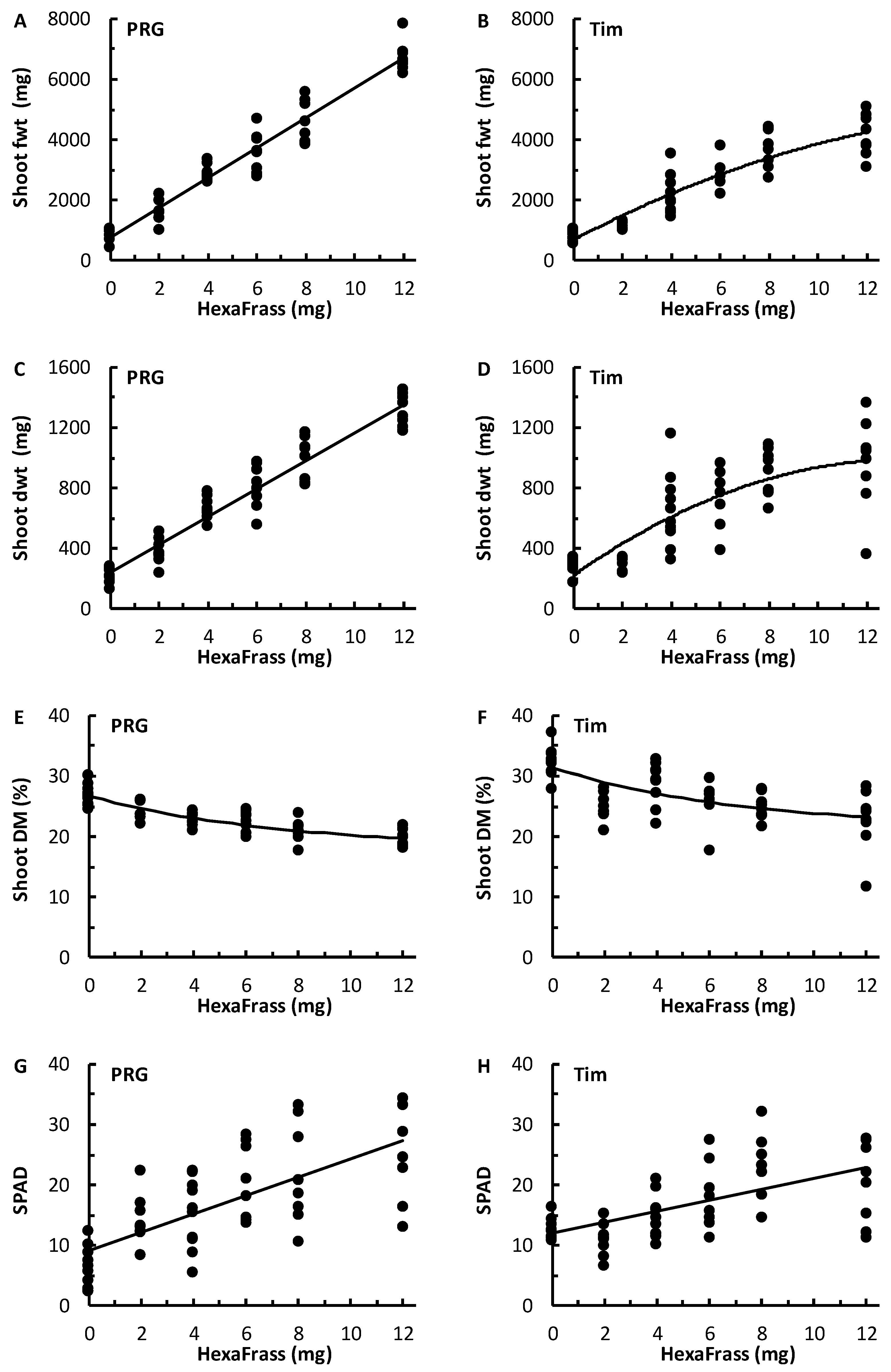
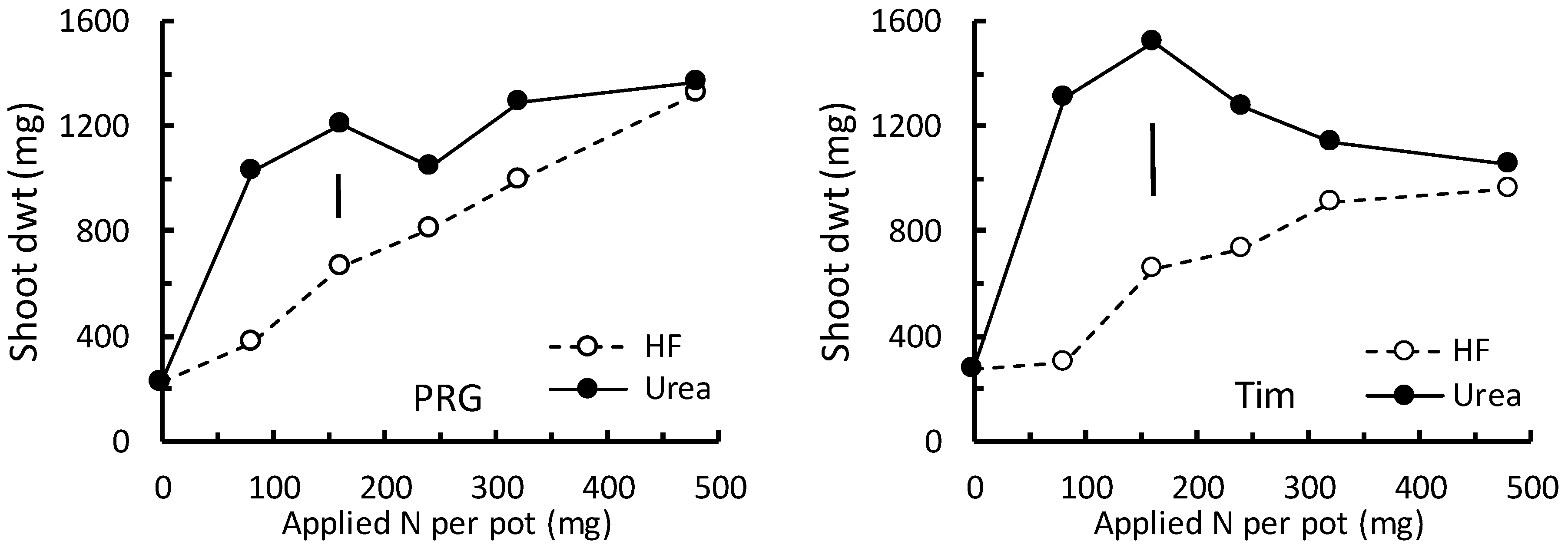
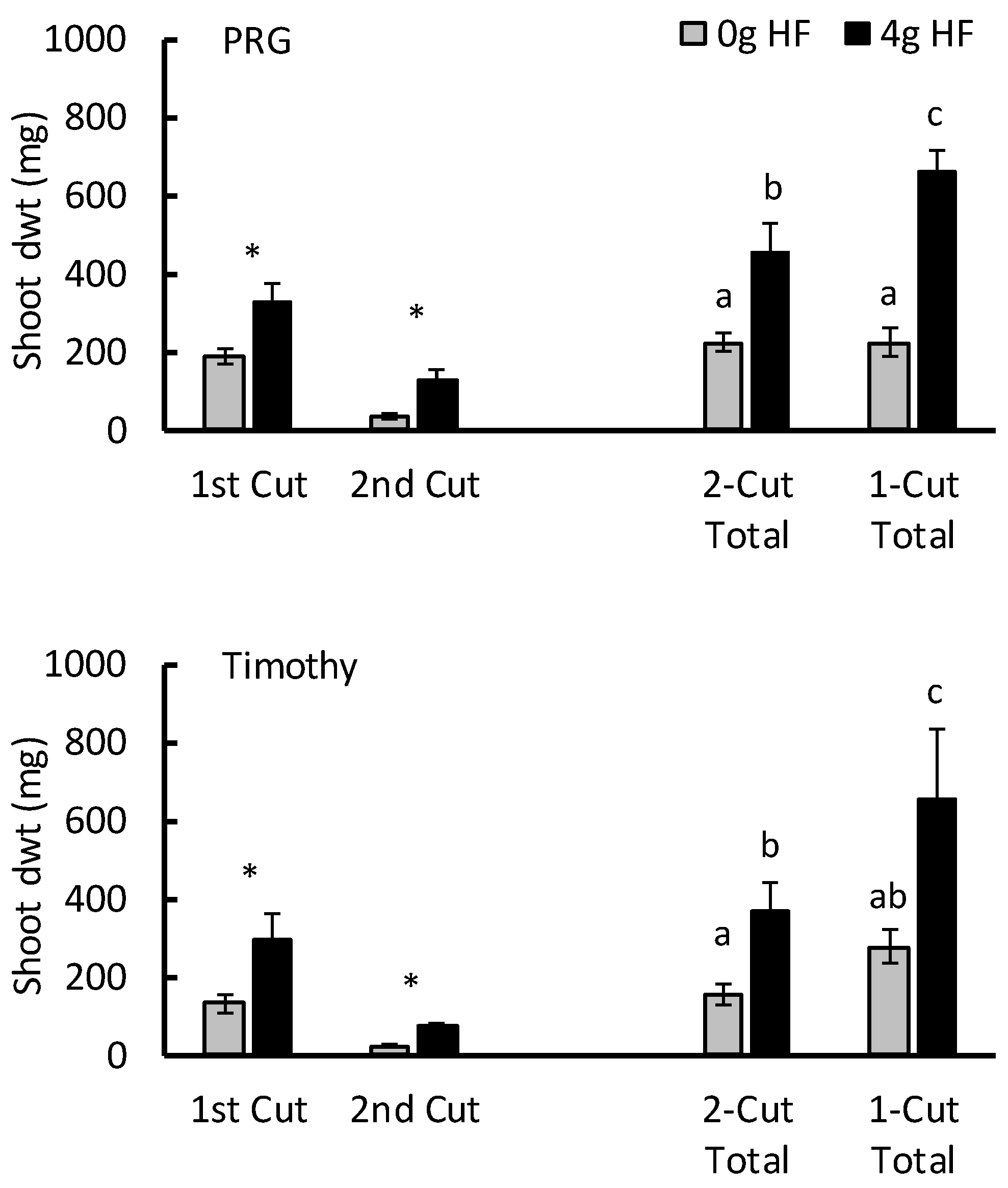
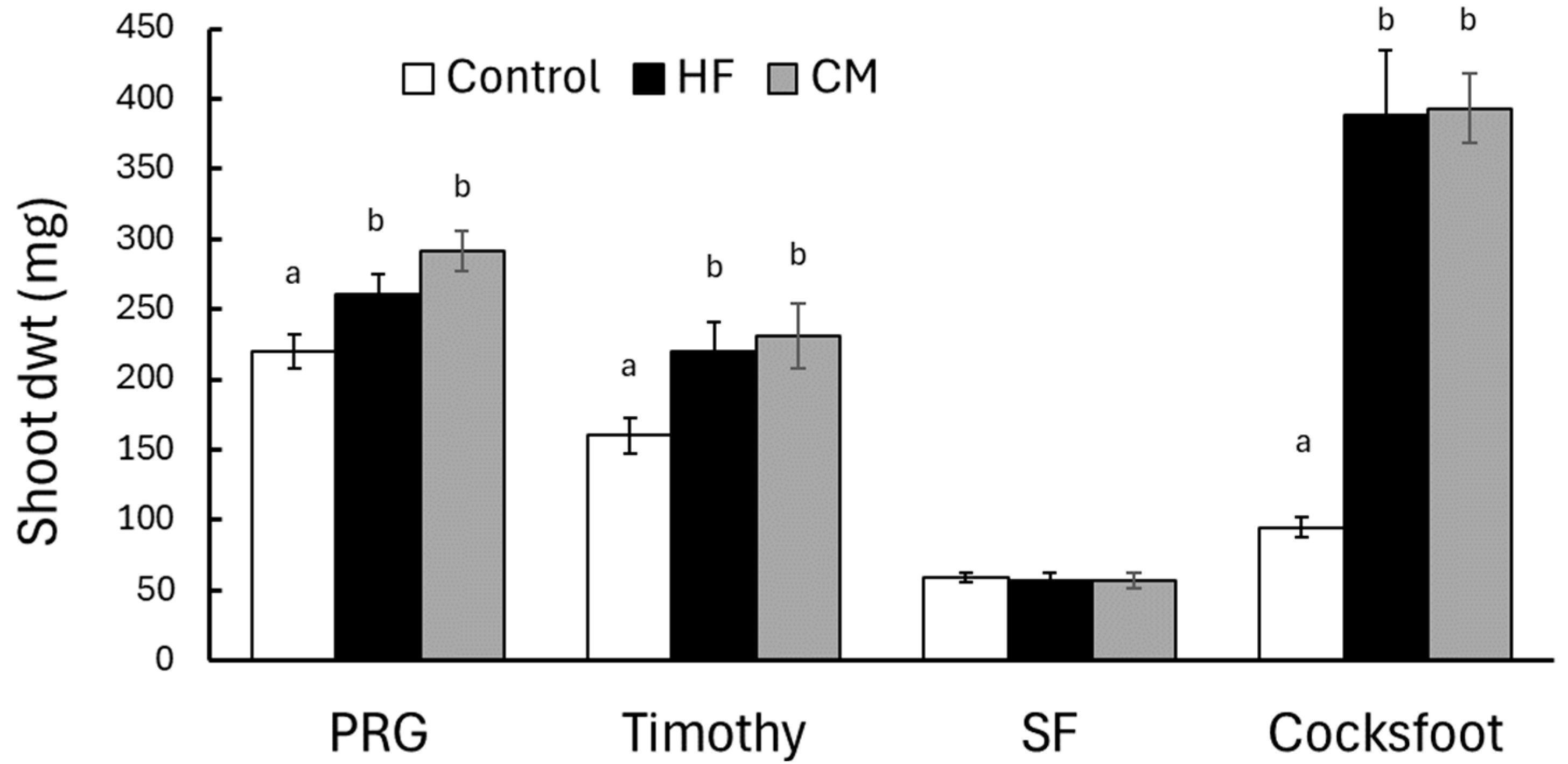
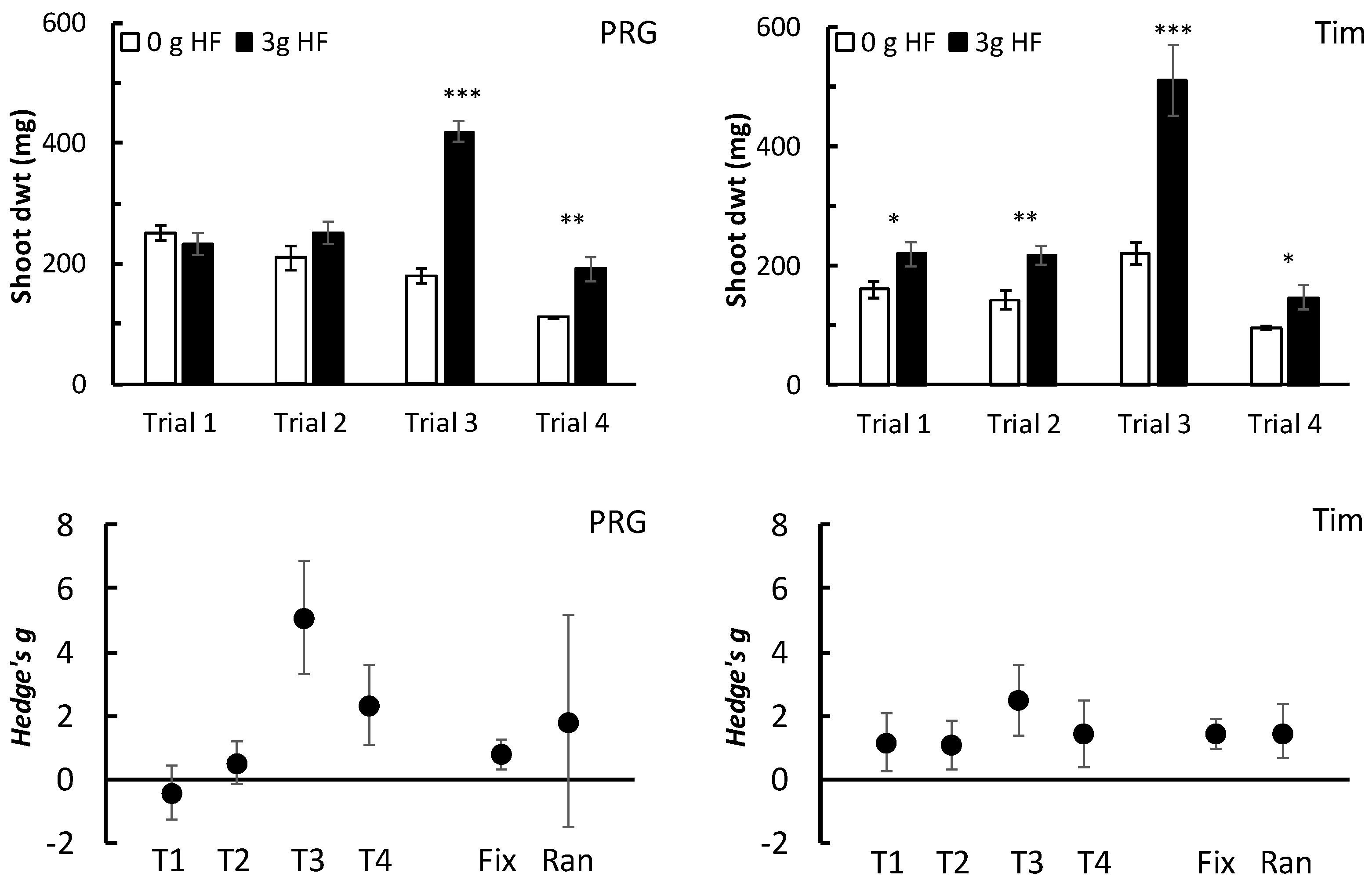
| Grass Species | Response | Relationship | r2 |
|---|---|---|---|
| PRG | Shoot fwt (mg) | 761.2 + 496.9HF | 0.95 |
| Shoot dwt (mg) | 239.6 + 92.7HF | 0.93 | |
| Shoot DM (%) | 18.0 + (8.7 × 0.873HF) | 0.70 | |
| SPAD | 9.2 + 1.5HF | 0.50 | |
| Timothy | Shoot fwt (mg) | 683.6 + 242.2HF − 10.6HF2 | 0.85 |
| Shoot dwt (mg) | 222.6 + 113.4HF − 4.2HF2 | 0.65 | |
| Shoot DM (%) | 21.3 + (10.1 × 0.870HF) | 0.34 | |
| SPAD | 12.0 + 0.9HF | 0.36 |
Disclaimer/Publisher’s Note: The statements, opinions and data contained in all publications are solely those of the individual author(s) and contributor(s) and not of MDPI and/or the editor(s). MDPI and/or the editor(s) disclaim responsibility for any injury to people or property resulting from any ideas, methods, instructions or products referred to in the content. |
© 2024 by the authors. Licensee MDPI, Basel, Switzerland. This article is an open access article distributed under the terms and conditions of the Creative Commons Attribution (CC BY) license (https://creativecommons.org/licenses/by/4.0/).
Share and Cite
Rodgers, E.; Nicolson, E.; Lauder, S.; Hodge, S. Response of Pasture Grasses to Organic Fertilizer Produced from Black Soldier Fly Frass. Plants 2024, 13, 943. https://doi.org/10.3390/plants13070943
Rodgers E, Nicolson E, Lauder S, Hodge S. Response of Pasture Grasses to Organic Fertilizer Produced from Black Soldier Fly Frass. Plants. 2024; 13(7):943. https://doi.org/10.3390/plants13070943
Chicago/Turabian StyleRodgers, Eoin, Elisha Nicolson, Sorcha Lauder, and Simon Hodge. 2024. "Response of Pasture Grasses to Organic Fertilizer Produced from Black Soldier Fly Frass" Plants 13, no. 7: 943. https://doi.org/10.3390/plants13070943
APA StyleRodgers, E., Nicolson, E., Lauder, S., & Hodge, S. (2024). Response of Pasture Grasses to Organic Fertilizer Produced from Black Soldier Fly Frass. Plants, 13(7), 943. https://doi.org/10.3390/plants13070943







